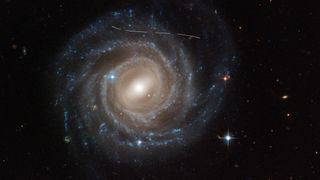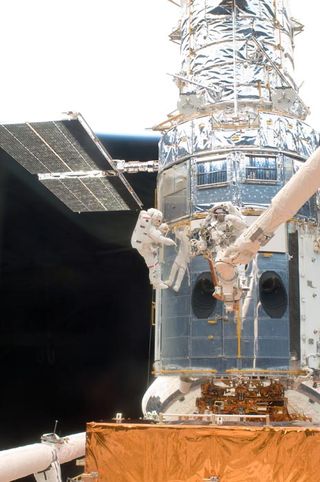We’ll have an update on NASA’s Hubble Space Telescope tomorrow (June 4), and it could be a big deal.
On June 3, the agency announced that the Hubble Space Telescope team would hold a press conference on the status of the observatory tomorrow at 4:00 p.m. EDT (2000 GMT). Specifically, officials said the purpose of this meeting would be to “provide an update on operations” of the telescope. Seems routine, right? Well, not necessarily. The Hubble Telescope team doesn’t hold press conferences like this often, especially one with just two presenters, both of whom sport rather lofty titles.
Mark Clampin, director of the agency’s Astrophysics Division and Science Mission Directorate at NASA Headquarters, will speak, as will Patrick Crouse, Hubble project manager at NASA’s Goddard Space Flight Center in Maryland.
Related: A billionaire hopes to improve the Hubble telescope on a private SpaceX mission, but could it really happen?
The news comes three days after NASA announced that Hubble had gone into automatic safe mode due to erroneous readings from one of its last three working gyroscopes, which are devices that help scientists ensure that the telescope is pointing in the right direction. Since its launch in 1990, Hubble has tested numerous gyroscopes, some of which have been replaced. Now there are three left.
Before you get too worried: yes, this may seem like a terrible combination of facts in isolation. However, there is some context in which to place them – one that gives hope that Hubble has not yet completed its tasks.
First, in its statement about the upcoming conference, NASA said something that agency officials have said repeatedly: “NASA anticipates that Hubble will continue to make discoveries, working with other observatories such as the agency’s James Webb Space Telescope, throughout this decade and into the next. »
It’s a sentiment that has been shared during previous gyroscope problems that Hubble has also faced, including earlier this year and late last year; the latter incident actually involved a short series of complications which were all resolved. Yet neither required a conference to inform the public of Hubble’s return. Online ads were enough.
This brings us to the next point: Hubble doesn’t really need all three gyroscopes to work.

As NASA stated, Hubble technically only needs one gyroscope to function properly – although, according to the European Space Agency (which is collaborating with NASA on the mission), the one-gyroscope mode may limit scientific observations to a certain extent.
Yet even if it turns out that the telescope’s now-faulty gyroscope doesn’t get back on track, there are two that may allow the cosmic explorer to continue exploring the universe. In 2004, for example, the observatory was placed in two-gyroscope mode after a planned maintenance mission by Hubble was canceled following the Space Shuttle Columbia tragedy. Eventually, Hubble Servicing Mission 4 replaced all six gyroscopes for the last time in 2009, and there was a fifth servicing mission afterward. But, once again, Hubble only has three of these gyroscopes left, one of which is the source of the last issue. The other three all experienced what is known as a “flexible cable failure,” related to the wiring.
According to a NASA breakdown, in the event that only two gyroscopes in total work, it is likely that the team will keep one and place the other in reserve. This way, if one of the two remaining gyroscopes fails, the other one that was resting will be fresh and ready for Hubble’s final game.
Home stretch ? Let’s hope not, but it’s unfortunately true that scientists believe the telescope could be decommissioned sometime in the mid-to-late 2030s, as the force of atmospheric drag from our planet slowly pulls the craft back out of its orbit at approximately 320 miles (515 kilometers) above Earth.
Such a decommissioning would involve either a controlled re-entry of the telescope into the Earth’s atmosphere or a small advancement of the telescope into a higher Earth orbit, where it could remain safely for a few decades. If Hubble re-enters the atmosphere, it would burn up much of the way other spacecraft do in the process – but it’s too big to destroy. fully burn. I imagine that anything that could be salvaged would be preserved with the honor it deserves.
If you’re stuck by this brief mention of maintaining the spacecraft in orbit, as astronauts did in its early years, it’s unclear if that’s even a possibility.
In the late 90s and early 2000s, brave NASA astronauts managed to get into Earth orbit and tinker with the observatory to install upgrades and apply renovations. The aforementioned Maintenance Missions 4 and 5 were part of this effort. Think of a microgravity body shop for a space telescope that also involves spacewalks.
Perhaps Hubble’s best-known servicing mission is the first, which took place shortly after the telescope was launched into space, because its basic science data appeared corrupted upon its return to Earth. The Hubble images were blurry, to put it simply, and scientists realized they had accidentally given the spacecraft a faulty mirror. No problem, said the agency, which sent astronauts to make the necessary adjustments. In the space!

Recently, billionaire Jared Isaacman, who has played a significant role in the commercial space sector through the success of the all-civilian Inspiration4 space launch he financed and his upcoming Polaris Dawn project, attempted to revive the concept of Hubble servicing . However, this concept has not yet come to fruition and it is not certain that it ever will.
That said — and I am aware of the hypocrisy behind what I am about to say — speculation is the enemy of optimism.
Theoretically, anything is possible, we’ll know more about Hubble’s fate soon, and it’s probably best to delay our worries until there’s something to worry about. Moreover, generally speaking, Hubble continued to broadcast space images as if nothing had changed. In fact, a new stellar portrait was released today and Hubble helped construct it. This is a very cool view of a newborn star that has a comet-like tail because other stars (hidden in the image) are pulling on its material.
Editor’s Update 6/3: On May 31, NASA announced that Hubble had entered safe mode.